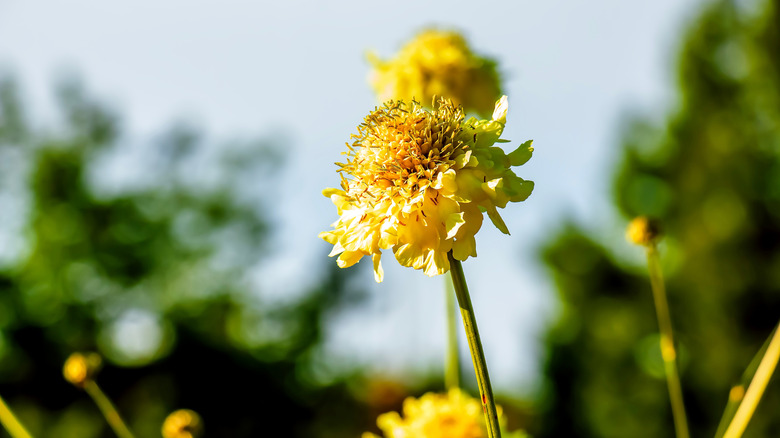The Butter Yellow Trend Isn't Just For Interiors — How To Use It In The Garden
The butter yellow trend — like all trends that seem to fire up overnight — has been ongoing for some time, often attributed to fashion writer Harling Ross Anton. Propelled by celebrity endorsements from the likes of Timothée Chalamet and Sabrina Carpenter, and a number of designers and fashion shows alike, the trend soon began to enter home interior as well. Martha Stewart, as always, was way ahead of the curve when she shared her butter yellow kitchen way back in the 1970s.
Although some people have historically dreaded the color for how flashy it can be, the feelings of optimism and warmth that this recent trend has been exhibiting have made yellow more than welcome in outdoor settings as well, especially the garden. With a number of stunning yellow flowers — which blend amazingly with natural textures like the light wood of gardens – alongside ways to enhance garden aesthetics with patio planters and garden linen, it's time your outdoors embraces the color of a warm hug.
While begonias, tulips, and daffodils are some of the flowers that naturally come to mind when you think yellow, you can opt for more subtle varieties too. Some of the soft-hued flowers that are perfect for you to incorporate the butter yellow trend include cultivars of yellow scabious, peony, cosmos, and beach sunflower. The light yellow shades of these flowers, which range all the way from vanilla to lemon, offer great pairings with plenty of other colors of flowers as well, such as purple, dark blue, and magenta pink.
Plant yellow scabious or Itoh peony to add more yellow to your yard
Yellow scabious (Cephalaria gigantea) is an excellent addition to your border garden, which will also complement nearby blue and purple flowers. These plants will invite more pollinators to your yard and garden, such as honeybees and butterflies. Their pale lemon hue adds a joyful vibe to the entire space, lifting up an otherwise bland area. At the same time, they aren't as bold as the audacious pink or purple you so often see in gardens. Being self-seeding, these soft-yellow beauties are totally capable of multiplying themselves. Suited for USDA Hardiness Zones 3 to 7, yellow scabious grow in full sun or partial shade. Not shy by any means, these plants are known to bloom for a long time.
Itoh peony (Paeonia 'Bartzella') is another flower to add if you don't quite like the idea of overwhelming your garden with bright yellow flowers, but still want to make the butter yellow trend work. With lemon-scented, soft-yellow, cupped flowers, this peony variety can be the standout in your garden, especially in the month of June when the flowers bloom. This cultivar of peony is hardy through zones 4 to 9.
Beach sunflowers and cosmos deserve a comeback in the landscape
Sunflowers often divide gardening enthusiasts — adored by many for its vibrant, happy color and snubbed by others for the same reason. In fact, yellow itself is a garden color that can be tricky to use but beautiful when done right. Having said that, there are plenty of sunflower varieties that blossom pale yellow and yet fall in line with the butter yellow trend. The beach sunflower (Helianthus debilis) is a reseeding annual that blooms from spring through fall, and can grow up to 6 feet tall. This yellow beauty can be also be grown as a perennial in zones 8 through 11. It needs well-drained, moist soil and full sun exposure. Just like scabious, these plants make excellent company to border plants and can also adorn your interiors as cut flowers.
'Xanthos', on the other hand, is an annual cosmos (Cosmos bipinnatus 'Xanthos') variety, fairly new to the scene but still massively adored. It blooms for a longer period (from June all the way to October) with beautiful flowers and butter yellow petals that look great both as border plants as well as in pots on the terrace or the patio. Just like sunflowers, these plants need full sun and become great companions to other plants in your garden, such as zinnias. Apart from elevating your butter yellow quotient, this variety of cosmos will also bring in a host of butterflies to further enhance your garden aesthetics.


